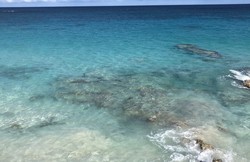Beneath the surface of the oceans, the Florida Keys Reef system is struggling to stay alive due to a chemical used in sunscreens, The New York Times reported.
According to the Florida Keys National Marine Sanctuary, the reef is the third largest living coral barrier reef system in the world.
Oxybenzone, a common chemical found in sunscreen, is toxic to the symbiotic algae of coral reefs. Gregory Moehring, Ph.D., an Associate Professor of Chemistry, said, “[It is] a petroleum-derived chemical with an arrangement of electrons within the molecule that allows for it to absorb ultraviolet radiation found in sunlight. Its solubility properties make the molecule effective in topically applied sunscreens.”
Jim Nickels, a Marine Scientist for Monmouth University’s Urban Coast Institute (UCI) said, “Corals have been under threat from a variety of sources, the ingredients in some sunscreens are having a direct affect causing bleaching, damaging their DNA, and causing deformities and death.”
An ecosystem once vibrant with colors is now going white, in the process Nickels mentioned as “bleaching.” If you are having trouble picturing bleached coral think of the way a tree appears in the winter: without life, barren, and brittle.
Jason Adolf, Ph.D., Monmouth University’s first endowed Associate Professor of marine science and a member of The Urban Coast Institute, explained what bleaching means for coral reefs. During bleaching, “Corals lose their symbiotic zooxanthellae, which are small algal cells living in the tissue of the coral animal, resulting in a white, ‘bleached’ appearance. Sometimes corals recover from these events, but sometimes the coral is lost and the ecosystem transitions to something totally different,” said Adolf.
When coral reefs turn to wastelands, other marine creatures suffer as well. According to the Reef Resilience Network, nearly everything in a coral-reef ecosystem depends on corals in some way. Coral colonies give food and shelter to many organisms, and their health is important for the ecology of the reef community.
“With the reefs, if you start to lose coral, all the other organisms that depend on them may also die, and in turn, the large fish and other creatures that depend on them are lost too. You go from an extremely productive area to a barren desert,” said Nickels.
When marine animals, such as dolphins, eat species living around the affected coral reef it can cause bioaccumulation. Nickels said, “Bioaccumulation is when the concentration of a chemical increases in an organism over time. It happens as you move up the food chain and can result in death.” Nickels also acknowledged that oxybenzone has been found to effect green algae, mussels, urchins, and fish.
Coral reefs also are threatened by, according to the Environmental Protection Agency (EPA), nutrient pollution, physical damage, over-fishing, and warming waters.
The good news is that states home to coral reefs are taking preventative action against sunscreens with these chemicals. The New York Times reported that in Hawaii and Key West, Florida, legislation has been passed to ban the sale of sunscreen containing ingredients threatening to coral reefs. This legislation is to be in effect Jan.1,2021.
The National Park Service has found that 4,000 to 6,000 tons of sunscreen enters reef areas each year, taking a visible toll on the ecosystem. Despite these findings, sunscreen manufacturers such as Johnson & Johnson have disputed the claims about the danger presented to coral reefs. The company’s statement read, “Concerns about the effects of oxybenzone on coral reefs have led to widespread misinformation about the safety of many sunscreens in the marine environment.
This spread of misinformation has real consequences, leading to actions that limit consumer access to sun protection and could potentially increase the risk of skin cancer from the sun.
The fact is, there is no credible science that demonstrates a link between sunscreens and coral reef bleaching.”
William Schreiber, Ph.D., Chair of the Monmouth University School of Science, has suffered from several bouts of skin canceroxybenzone.
“I noted just this morning that a new bottle of Lubriderm moisturizer lotion with sun protection that my wife and I use during spring and summers contains oxybenzone and three other sunscreen chemicals. Having had skin cancer, I value the protection products like this offer,” said Schreiber.
Regarding coral reefs, Schreiber added, “There are media reports that this chemical may be involved in bleaching of coral, an environmental concern. From my limited research, the published basis in the Archive of Environmental Contamination and Toxicology is not relevant to the small amounts that get into oceans from use by swimmers.”
Schreiber explained that coral bleaching is definitely happening. “But from my quick search of the subject, the main cause, both direct and indirect, is global warming,” he said.
Some sunscreen brands that contain chemicals threatening to coral reefs include Coppertone Sport SPF 50 Lotion Sunscreen and Coppertone Water Babies Lotion.
In tandem with this list, Hawaii.com published reef safe sunscreens, in lieu of their bill passing, which include: Suntegrity Natural Mineral Sunscreen, Loving Naturals Clear Body SPF 30+ All-natural Sunscreen, and SunBum Moisturizing Sunscreen Lotion SPF 50.
As a regular sunscreen user, President of the Monmouth University Surf Club, Josh Spicer, believes, “The problem is that people don’t like spending a lot of money on sun protection, so they go to companies that sell a cheap product. There are plenty of small name companies (like the above mentioned) that provide safe, organic sunscreen.
If we really want to protect our waters, more regulations should be put in place to help protect the environment from these poisons we are putting in our oceans and our bodies.”
A world where coral reefs are a kaleidoscope of colors, and the marine life they sustain are full of hope, is the ideal outcome from becoming conscious of the sunscreen ingredients in stores.
William Martin, a senior biology student, is an avid surfer who has experienced the wonder of coral reefs in person.
“Part of the surfing culture is to respect the environment that we are immersed in when we surf. As a biology major, I have learned how sunscreen is essential to surfers, especially ones from the east coast, that may travel to other parts of the world where the UV is stronger,” he said.
“However, the effects of the chemicals in sunscreen can really damage the ecosystem we are surrounded in. Coral reefs are an amazing ecosystem and is one that is essential to surfing as a sport.
“The preservation of reefs, and all the ocean is of the top concerns for me as a surfer and waterman. I applaud the actions Hawaii and Key West have made to prolong or revive the ecosystem that our world can lose,” continued Martin.
John Tiedemann, Assistant Dean of the School of Science, and New Jersey Organization, Clean Ocean Action could not be reached for comment on this topic.
PHOTO TAKEN by Chloe Barone



